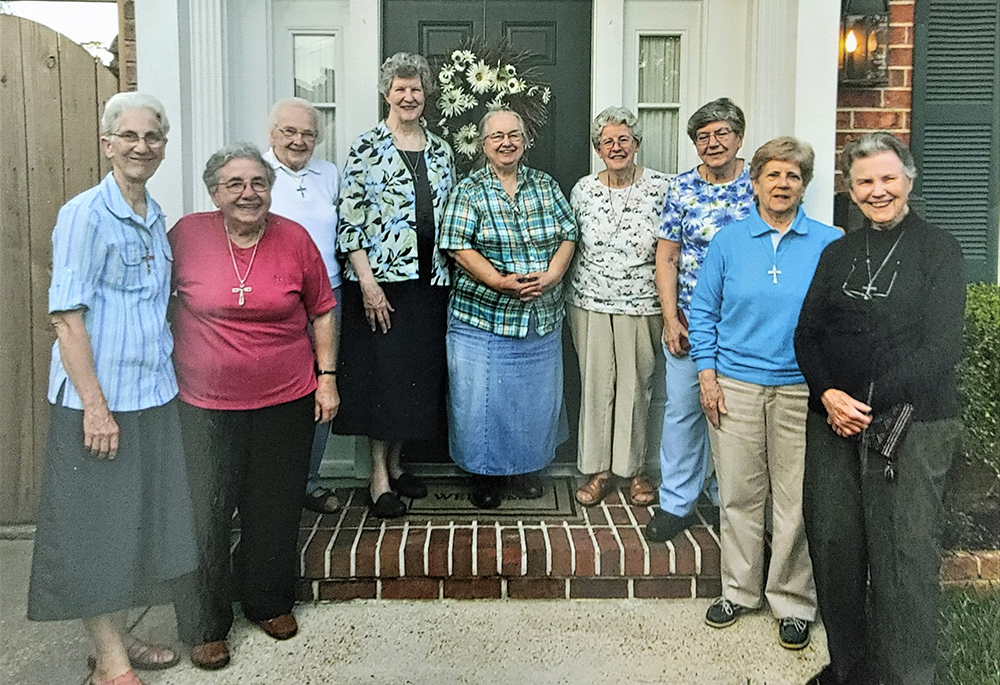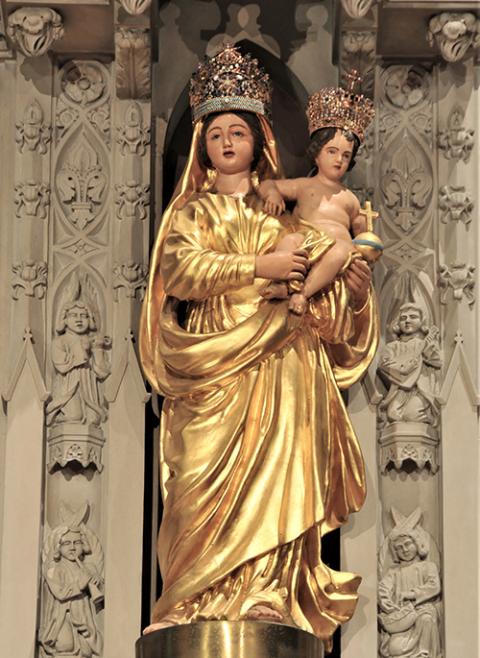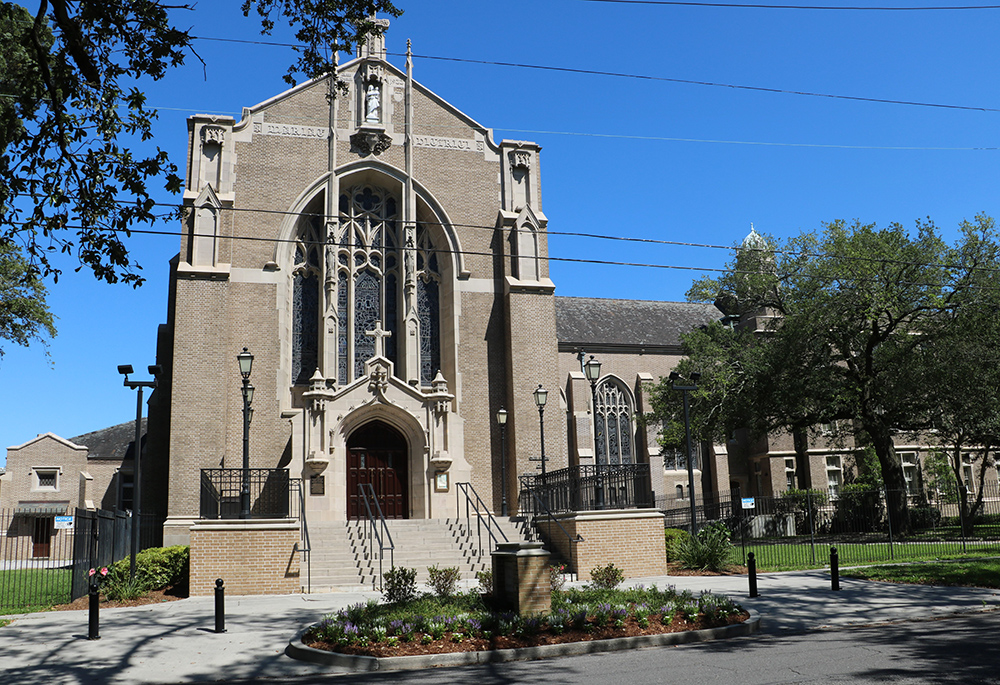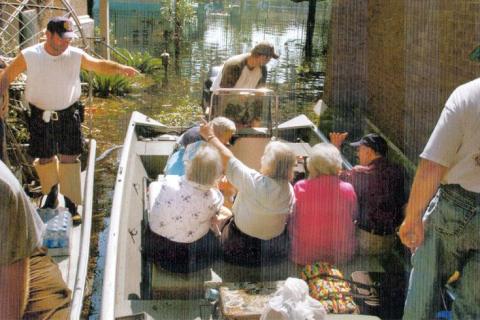
Sr. Carolyn Brockland (fourth from left) and the Ursuline community in New Orleans in 2017 (Courtesy of The National Votive Shrine of Our Lady of Prompt Succor)
Each new report of extreme weather begs the question, "Is this the new normal?" Across the world, we are learning what it means to adapt and adjust to climate change as well as what it means to heal our communities, including Earth herself. Ursuline Sr. Carolyn Marie Brockland comes from a community experienced with resilience and recovery.
The Sisters of the Order of St. Ursula arrived in New Orleans in 1727. They established Ursuline Academy, the first Catholic school for girls in the United States, and the sisters have been a constant presence for the city of New Orleans ever since. For more than 200 years, the Ursulines have taught Louisiana to pray for "quick help" from Our Lady of Prompt Succor.
The only time New Orleans went without the presence of the Ursuline nuns was during Hurricane Katrina. They left just as their predecessors arrived: by boat. Sr. Carolyn Brockland, prioress of the community at the time, shares about the collective wisdom from a persistent and hopeful community guided by Our Lady of Prompt Succor. Responses have been edited for clarity.

The Ursuline sisters of New Orleans are rescued by boat roughly a week after Hurricane Katrina hit in 2005. Ursuline Sr. Carolyn Brockland said that the sisters insisted the neighbors sheltering with the sisters also be evacuated. The sisters took special care to make sure each boat had both sisters and laypeople so that no one got left behind (including the dogs). (Courtesy of The National Votive Shrine of Our Lady of Prompt Succor)
GSR: The Ursuline sisters have a special devotion to Our Lady of Prompt Succor. Could you share the story of Our Lady and how she came to be the patron saint of Louisiana?
Brockland: The sisters always needed help. By 1803, the colony had been ceded from Spain back to France. The Spanish sisters left for Cuba. So, they had all of their work and half the people.
One of the sisters had a cousin who was a nun in France, but because of the French Revolution, she was no longer allowed to be a nun. The Ursuline sister in New Orleans asked her cousin if she could come and bring some young women to help. Then, she could be a sister again. As a courtesy, she asked the bishop who said to ask the pope, then a prisoner of Napoleon. She prayed to Mary, "If I have a prompt and favorable answer, I will have you honored in Louisiana." Mary answered. Within a very unexpected amount of time, the pope did get the letter, and she did get a favorable reply. She commissioned the wood-carved statue we now have and brought it with her here from France.

A prayer card for The National Votive Shrine of Our Lady of Prompt Succor shows Mary holding a child with both hands, with swishing garments to show she's in a hurry as she is packing up and boarding a boat. The statue was carved specifically for this shrine. (Courtesy of The National Votive Shrine of Our Lady of Prompt Succor)
The War of 1812 arrived shortly after the statue. Again, the power of prayer. The sisters prayed all night. People in the city who weren't preparing for battle joined them. They were in the middle of Mass the next morning at 6 a.m., at Communion, when the messenger arrived and said that the battle was won. The Americans had won, and the war was over. It's considered the most miraculous example of quick help you could think of! With very little loss of American life, in a very short time, and against all odds, that battle was won.
So, the sisters made a vow that every year on the anniversary of that battle, there would be a Mass of thanksgiving offered. From the beginning, we were connected to the city and the development of the city. Our Lady of Prompt Succor is for everybody, not just the sisters and not just those who come to school here. She is the patroness of Louisiana, but the center of the devotion is here. The miraculous statue is here.
Most recently, you have served at the center of that devotion, as the director of the National Shrine of Our Lady of Prompt Succor. Could you describe what the shrine is like and your role in this sacred space?
The shrine is beautiful. But the place is sacred because of the prayers and faith of the people who have prayed to Mary under that title: people who have come here, who have sent their requests for us to pray for them or their loved ones. All of that is so important.
Part of what the director does, besides trying to promote the devotion, is to find donors who want to help us maintain the chapel and make it a place of prayer and comfort for people. Besides daily Mass, we have weddings, baptisms, funerals, tours, and people who come on pilgrimage. We are open for anyone, and people come! We invite, we welcome, but they get the word out, the word spreads, and people come.

The National Votive Shrine of Our Lady of Prompt Succor is preparing to celebrate its 100th anniversary since its dedication on State Street in New Orleans. Throughout 2024, centennial celebrations will be held, including special liturgies, concerts and historical events. (Courtesy of the National Votive Shrine of Our Lady of Prompt Succor)
It sounds like ritual is one way the Ursulines contribute to the New Orleans community. Did the shrine take on a special significance for people after Hurricane Katrina since the sisters were so vital to the neighborhood?
We use our ceremonies to tell our stories. When we first came back, we needed to get ready for Jan. 8. That's our big celebration for Our Lady of Prompt Succor. The push was on to get the electricity back on in the shrine by then.
The night before, one of the electricians came up to me and said, "We got them on, but we had a terrible time so don't turn them off. I live in Bogalusa, and it will take me four hours to get back here." We left the lights on all night and had a full celebration the next day.
When school started again, the elementary students planted the first tree. All the trees in the courtyard had either been blown down or died. It was just a barren, ugly place. So, they decided to plant the first tree as part of the celebration, and the grade school kids were part of it. That was their way of ritualizing their coming back.
You were prioress of the community during Hurricane Katrina. What did you learn about resilience and recovery from that experience?
When Hurricane Katrina hit, we were surrounded by water. People came here to take shelter because we didn't evacuate. We had never gone anywhere. We were always here for people. By the time we collected everybody, we had over 40 people, plus the sisters. We had kids, elderly people in their 90s, a whole range of people. We were there a whole week. We got through it because we organized. Everyone pitched in. Someone would ask, "What can I do?" and I would say just keep an eye out, and if somebody looks like they're having a bad day, just sit and talk with them for a little bit, and help them say what's bothering them.

The Ursuline sisters of New Orleans are rescued by boat roughly a week after Hurricane Katrina hit in 2005. (Courtesy of The National Votive Shrine of Our Lady of Prompt Succor)
That was part of what kept us going. We really formed a community in spite of everybody being so stressed. So many people were frail and elderly, and it was hot as blazes. We really weren't getting much sleep. It was awful.
But one of the things that we did, how we would get sustained, was the chapel. Every day, we had a Communion service for people who wanted to come. Some gathered to say the rosary before we started the Communion service. That was comforting. It was our faith that really comforted us. I knew that God would see us through. I didn't know how it was going to turn out. I had no idea how traumatized we all were until after the fact. God got us through it, and all those people were safe. Nobody died.
When we were planning the recovery, the plan was to build back better. Each building we would take our time, raise the money, and make it better than it had been. There was some improvement in each building. It was probably 10 years or more before all that got done, but it's better. Things are improved from what they were originally.
At first, the loss is just devastating, and you can't imagine how you're going to do it. What gets me through those moments is knowing God is there. I knew God was with me. I couldn't have been the leader that was needed, to help everybody stay as calm as possible and as hopeful as possible in such a terrible time if I didn't know that God was the one giving me the grace to do it. It wasn't me. I just needed to get out of the way and let God do it through me.
Advertisement
What collective wisdom has your community gathered that you would share with others experiencing natural disasters and extreme weather now?
Between our prayer and our own experiences having been through hard times before this one, we got through it. And I think that's what I would say to people today. It's going to be terribly hard, and it's going to have an impact on you. When I hear about a hurricane in the gulf that might be heading our way, my whole body tenses up … still long after the fact because it wasn't just that week. It was months, and some things took years.
We pray for Mary and ask for quick help, but we sure didn't get it with Katrina. How was Mary with us then? Well, Mary was with us because she helped us get through it, helped us help each other, helped us work together, and find other helpers to coordinate the help to rebuild our city.
We find ways to do what we can, and God shows us the way. I think that is true whatever the difficulty is, whether it's a serious illness or a crisis of family, whether it's crisis in terms of climate change … God will be with you. God will help you if you can let go and let God do what God can do with you, for you and through you for others.







